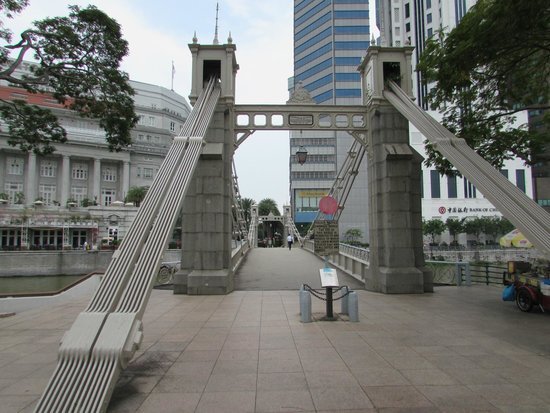Cavenagh Bridge
1 Fullerton Square, Singapore 049178

This photo of Cavenagh Bridge is courtesy of TripAdvisor
Cavenagh Bridge is the only suspension bridge and one of the oldest bridges in Singapore, spanning the lower reaches of the Singapore River in the Downtown Core. Opened in 1870 to commemorate Singapore’s new Crown colony of the Straits Settlements status in 1867, it is the oldest bridge in Singapore that exists in its original form.
Cavenagh Bridge is currently a pedestrian bridge, with lighting added in the 1990s to accentuate its architectural features at nightfall.[1] It now provides the most convenient pedestrian link between the cultural district at the north bank and the commercial district to the south of the Singapore River, and complements the renovated Fullerton Hotel (previously Fullerton Building) which is sited beside the bridge.
There are numerous sculpture works near the Cavenagh Bridge, including a family of Singapura cats (kucinta or drain cats), recognised as one of the smallest breeds of cats in the world, located at the southwest abutment.
On 3 November 2008, the bridge was selected for conservation as part of the Urban Redevelopment Authority’s expanded conservation programme. Currently it became a national monument.
This bridge has elaborate suspension struts in comparison with most other suspension bridges, and is the third bridge to be built in Singapore. It was constructed in 1869 to allay the inconvenience of crossing the Singapore River by boat. It was originally designed as a drawbridge but on its completion was found to be suitable only as a fixed structure. Numerous steel rivets were used in its construction, which employed steel casting methods commonly used during that era.
When Cavenagh Bridge became unable to cope with the increasing traffic into town and its low draught was insufficient for the passage of boats at high tide, the government decided to build the Anderson Bridge in 1910 to replace Cavenagh Bridge. Cavenagh Bridge was eventually spared from demolition and was converted to a pedestrian bridge, with the road traffic diverted to the Anderson Bridge. A police notice, which is still preserved till today, was thus erected at both ends of the bridge restricting the passage of vehicles that weighed beyond 3 cwt (152 kilograms or 336 pounds), including cattle and horses.
Source : wikipedia
https://www.youtube.com/watch?v=j_EhTX1PsiY
https://www.youtube.com/watch?v=sRl0qQyyLa4
https://www.youtube.com/watch?v=30GJVH03g1Y
Reviews
Getting there : MRT : Raffles Place (Exit H, turn right)


Rate this article